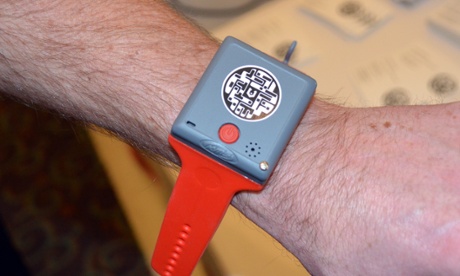
The ability to track the location - and perhaps behaviour - of children - has become a reality thanks to a team from Manchester and what they claim is a "first of its kind" GPS tracker and mobile phone wristband.
Hidden in the depths of the auxiliary halls at the CES gadget show in Las Vegas is a small British company usually based in Manchester’s MediaCityUK, showing off a prototype its pioneering wearable safety device for children and the elderly.
Working in conjunction with Manchester University, KMS say its wristband is essentially a very simple small, wrist-worn mobile phone with integrated GPS that has just one button.
Panic button
It works like a panic button that when pressed dials a series of pre-programmed phone numbers until it gets an answer from a human, automatically detecting answer machines and skipping to the next number in the list.
“Simplicity was the key for our target audience of children and vulnerable adults. It had to be easy enough for anyone to use, even for those people who would not be able to operate a standard mobile phone,” said Chris Etchells, co-founder of KMS talking to the Guardian at CES.
The Wristband is charged wirelessly and the battery lasts around two days of use, but will notify the manager of the device when it hits 20% battery by email, and then call the designated number at 10% battery.
KMS also made the wristband automatically answer incoming calls, allowing parents, relatives and friends to call to check up on the child even if they wouldn’t necessarily answer a ringing phone from their parents.
It works like a panic button that when pressed dials a series of pre-programmed phone numbers until it gets an answer from a human, automatically detecting answer machines and skipping to the next number in the list.
“Simplicity was the key for our target audience of children and vulnerable adults. It had to be easy enough for anyone to use, even for those people who would not be able to operate a standard mobile phone,” said Chris Etchells, co-founder of KMS talking to the Guardian at CES.
The Wristband is charged wirelessly and the battery lasts around two days of use, but will notify the manager of the device when it hits 20% battery by email, and then call the designated number at 10% battery.
KMS also made the wristband automatically answer incoming calls, allowing parents, relatives and friends to call to check up on the child even if they wouldn’t necessarily answer a ringing phone from their parents.
Geo-fencing and tracking
Coupled to the mobile phone is an assisted GPS chip, which allows parents or carers to track the wearer on a map using a website or smartphone app.
KMS has also developed a geographic ring-fencing feature, which automatically tracks the child wearing the wristband and notifies its parents when it leaves a pre-defined safe zone or route of travel, allowing them to call the band.
On top of the band is a Vcode 2D barcode which encodes information about the person wearing the band including their blood type, their allergies and an emergency contact number, should the child or wearer get lost or involved in an incident.
“It took eight months to develop, but I’ve been working on the idea behind it for the best part of 10 years,” said Etchells talking about how he came up with the concept while working with vulnerable adults.
Etchells explains that in the testing of the device, rather than feeling like they were being watched, the child testers saw it as a gateway to allowing them to play outside without supervision, as the parents felt more comfortable letting the kids play knowing they could keep an eye on them remotely and track them if they wandered off.
The wristband is in its final stage of development, and is expected to be ready for production and will then go on sale for about £200 in September 2014.
Credit to the Guardian
Coupled to the mobile phone is an assisted GPS chip, which allows parents or carers to track the wearer on a map using a website or smartphone app.
KMS has also developed a geographic ring-fencing feature, which automatically tracks the child wearing the wristband and notifies its parents when it leaves a pre-defined safe zone or route of travel, allowing them to call the band.
On top of the band is a Vcode 2D barcode which encodes information about the person wearing the band including their blood type, their allergies and an emergency contact number, should the child or wearer get lost or involved in an incident.
“It took eight months to develop, but I’ve been working on the idea behind it for the best part of 10 years,” said Etchells talking about how he came up with the concept while working with vulnerable adults.
Etchells explains that in the testing of the device, rather than feeling like they were being watched, the child testers saw it as a gateway to allowing them to play outside without supervision, as the parents felt more comfortable letting the kids play knowing they could keep an eye on them remotely and track them if they wandered off.
The wristband is in its final stage of development, and is expected to be ready for production and will then go on sale for about £200 in September 2014.
Credit to the Guardian
No comments:
Post a Comment